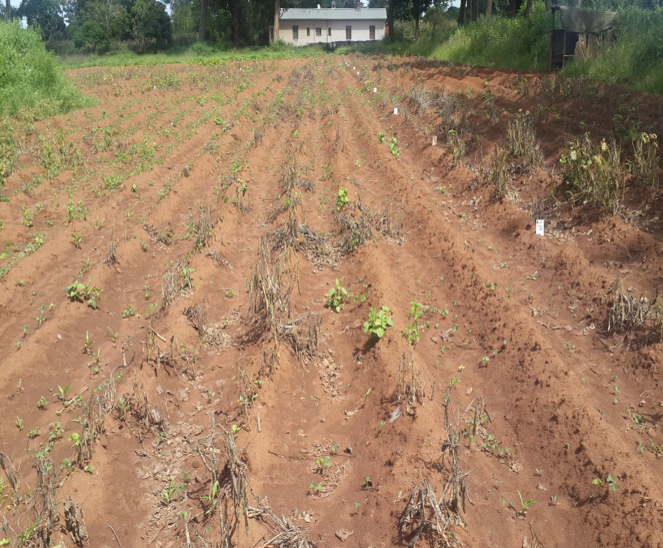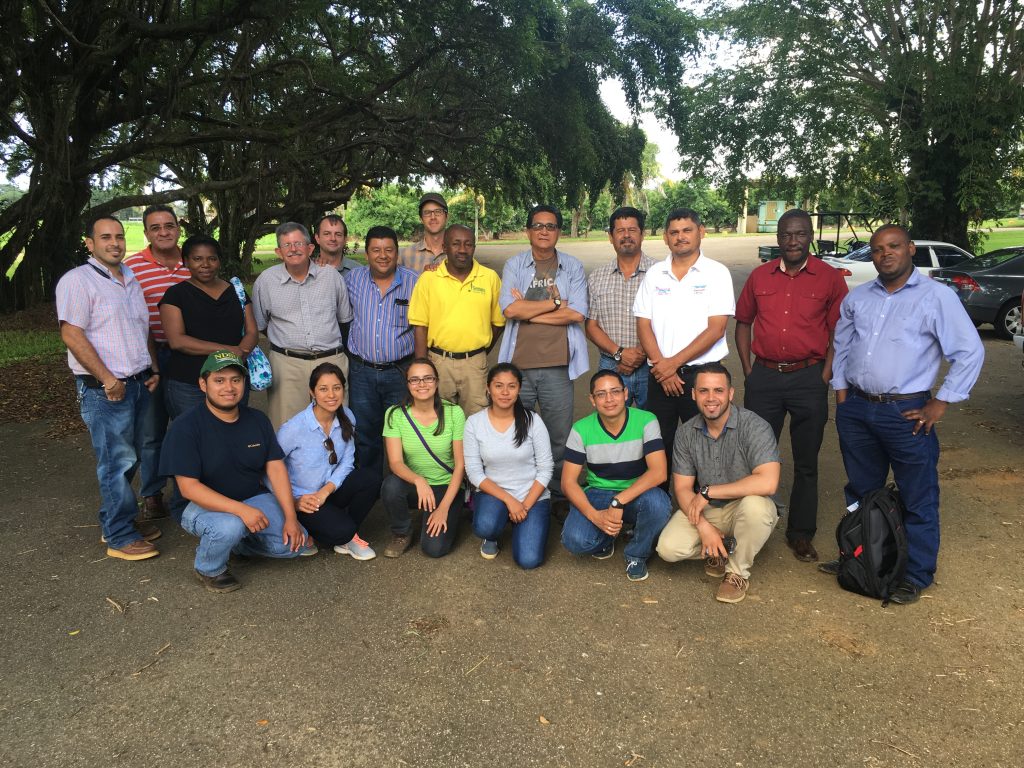- CENTA Chaparrastique, nueva variedad de frijol rojo, 2011
- CENTA Costeño, nueva variedad de frijol rojo para altas temperaturas, 2014
- CENTA CPC, nueva variedad de frijol rojo claro brillante, 2008
- CENTA EAC, nueva variedad de frijol rojo claro, 2015
- CENTA Ferromas, nueva variedad de frijol con mejor valor nutricional
- CENTA Nahuat, nueva variedad de frijol rojo claro, 2008
- CENTA Tacuba, nueva variedad de frijol negro brillante, 2018
- Costa Rica Nambi, nueva variedad resistente a sequía, 2017
- Costa Rica, Variedades de frijol grano rojo PITTA-Frijol, 2007
- Cuba, Cadena de valor de frijol, 2016
- Cuba, Lista de variedades comerciales, 2017-2018
- El Salvador, Brochure variedades de Frijol FP, 2012
- Guatemala, Recomendaciones técnicas para el cultivo de frijol en Peten, 2015
- Honduras, Variedades de frijol liberadas, 2018
- ICTA Chorti ACM Variedad de frijol arbustivo biofortificado con hierro y zinc, 2017
- ICTA Labor Ovalle, nueva variedad de frijon de enredo tipo bolonillo
- ICTA Peten ACM e ICTA Sayaxche, Nuevas variedades de frijol para el Peten, 2010
- ICTA Superchiva, nueva variedad de frijol, 2011
- ICTA Utatlan, nueva variedad de frijol de vara o enredo, 2017
- IDIAF Charlona Negra, nueva variedad de habichuela negra, 2017
- IDIAF DPC-40, nueva variedad de habichuela negra
- IDIAF Yaconin, nueva variedad de habichuela crema moteado, 2017
- Nicaragua, Variedades tolerantes a sequía, Noel Duarte
- P. Rico, B-128, B-190, B-351, 2B-5-1 Release of black beans 1979
- Rep. Dom., Socializacion de resultados de investigación
- Variedades de frijol liberadas-AgroMeso, 2004
Category Archives: Useful Materials
Historical Common Bean Research Publications from Puerto Rico
- Release of Violeta – 1976
- Release of Palmarejo – 1976
- Release of Oro Rico – 1976
- Release of multiple disease resistant scarlet runner bean germplasm – 1979
- Release of MITA-76-R287 – multiple disease resistant black bean – 1979
- Release of MITA RSP-1, RSP-2, RSP-3 and RSP-4 – 1979
- Release of Congo Rico – 1976
- Release of Chorro – 1979
- Release of Carbon – 1979
- Release of black beans B-128, B-190, B-351, 2B-5-1 – 1979
- Release of black bean La Vega -1973
- Release of 4M-99 – multiple disease resistance – 1983
- Release of kidney beans 3M-150 and 3M-152 – 1983
- Release of Mogote – 1979
- Release of XR235-1-1 – common blight resistant interspecific line – 1981
- Release of white beans W-117, W-142 and 2W-33-2 – 1979
- Release of white bean MITA 6383 – 1979
- Release of white bean lines L226-10 and L227-1 – 1983
Central American/Caribbean Regional Bean Research Workshop (July 25-27, 2017)
The SO1.A4 Project of the Legume Innovation Lab held a workshop in Tegucigalpa, Honduras from July 25-27, 2017. The program and relevant presentations representing Central American/Caribbean regional bean research efforts are posted. All workshop presentations available for download are in Spanish. The summary of the workshop in available in English here.
Workshop schedule in PDF Format (download)
Tuesday, July 25, 2017
Report of research achievements for the past five years
(Click on bulleted text to download PDF)
- Panama (Emigdio Rodríguez)
- Costa Rica (Juan Carlos Hernández)
- Nicaragua (Aurelio Llano) (not available)
- Honduras (Danilo Escoto)
- El Salvador (Aldemaro Clará)
- Guatemala (Angela Miranda)
- Mexico – IDIAF (Francisco Ibarra)
- Haiti (Raphael Colbert)
- Dominican Republic (Bernardo Mateo)
- Zamorano (Juan Carlos Rosas)
- Puerto Rico (UPR and USDA-ARS) (James Beaver and Consuelo Estevez)
Wednesday, July 26, 2017
Research priorities for the next ten years
(Click on bulleted text to download PDF)
- Panama (Emigdio Rodríguez)
- Costa Rica (Juan Carlos Hernández)
- Nicaragua (Aurelio Llano) (not available)
- Honduras (Danilo Escoto)
- El Salvador (Aldemaro Clará)
- Guatemala (Angela Miranda)
- Mexico – IDIAF (Francisco Ibarra)
- Haiti (Raphael Colbert)
- Dominican Republic (Bernardo Mateo)
- Zamorano (Juan Carlos Rosas)
- Puerto Rico (UPR and USDA-ARS) (James Beaver and Consuelo Estevez)
Wednesday, July 27, 2017
Featured Articles – Feed The Future Bean Research
Featured Articles – Feed The Future Bean Research
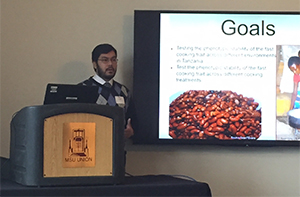
Diego Crespo an undergraduate assistant studying cooking time in dry beans in Karen Cichy’s lab wins the grand prize for his research presentation at the Michigan State University Undergraduate Research and Arts Forum in April 2016.
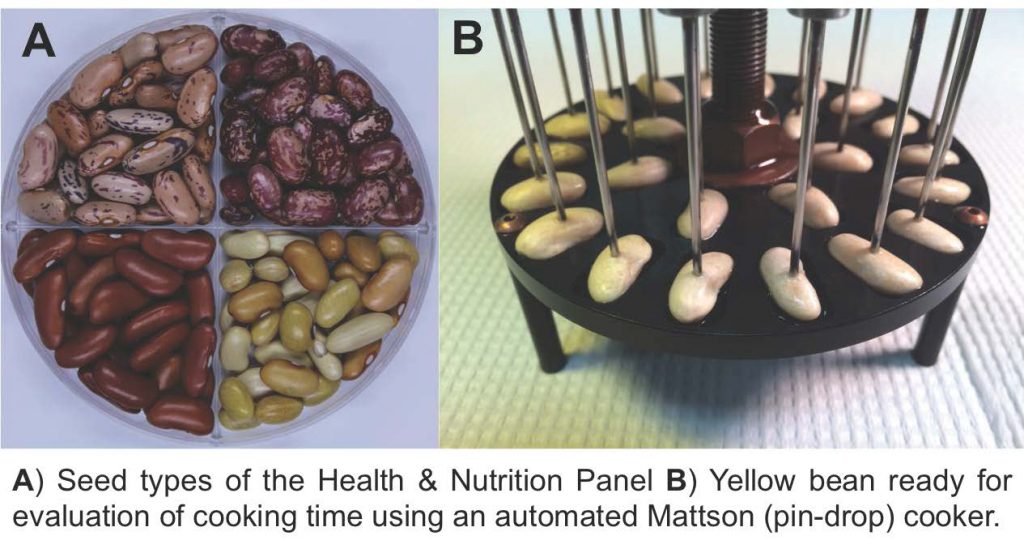
“Fast-cooking dry beans provide more protein, iron than ‘slower’ varieties” news story highlights the research study “Demonstrating a Nutritional Advantage to the Fast-Cooking Dry Bean (Phaseolus vulgaris L.)” by Jason Wiesinger, Karen Cichy et al. published in the Journal of Agricultural and Food Chemistry in November 2016.
Shipment of 12 tons of virus resistant black bean ‘Sankara’ to Haiti
In collaboration with the University of Puerto Rico, Basin Seeds Inc. (Idaho), and USAID, the USDA-ARS Feed-the-Future Grain Legumes Project shipped over 12 tons of ‘Sankara’ black bean seed to Haiti that arrived on Nov. 16, 2016. This seed, urgently needed due to hardships caused by Hurricane Matthew, was produced with the goal of testing a model for providing a secure, annual supply of high quality, disease-free, Western U.S. grown common bean seed to countries such as Haiti that have a perennial shortage of seed and are vulnerable to extreme weather events including droughts, tropical storms and hurricanes.
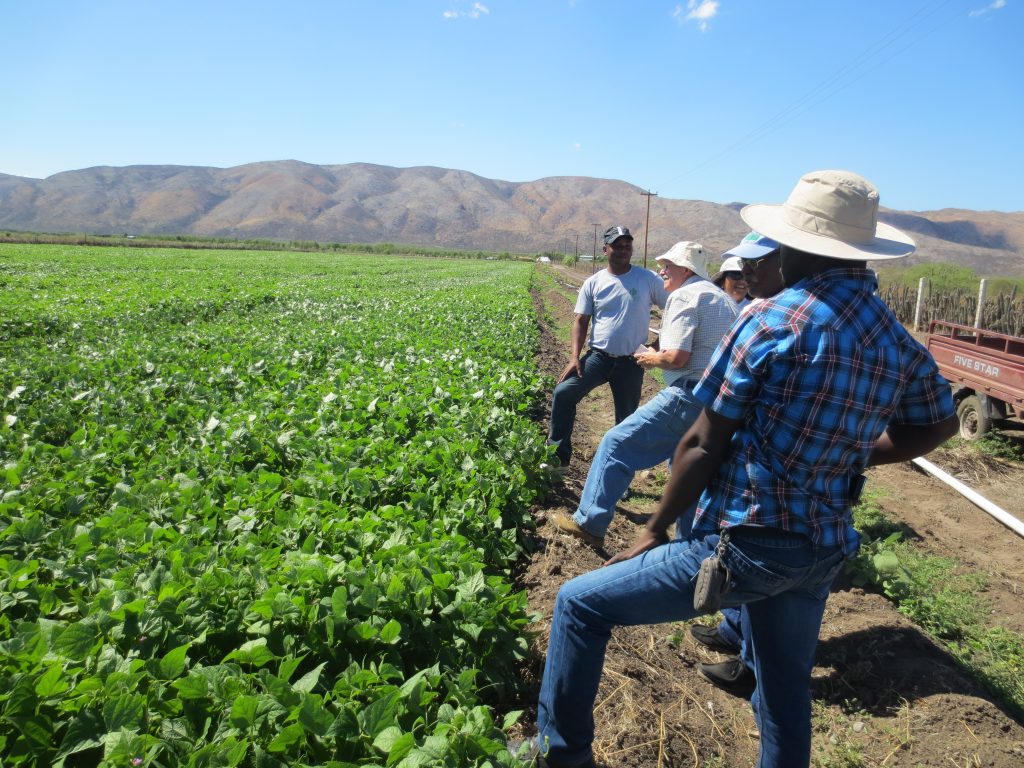
Seed increase of Sankara in February 2014 at the Hands Together NGO in Gonaives, Haiti. In the photo are Jim Beaver and Consuelo Estevez of the U. of Puerto Rico, Emmanuel Prophete from the National Seed Service of Haiti, and several technicians from the NGO.
‘Sankara’, tested as XRAV-40-4 and released in Haiti in 2015 has good yield potential and resistance to BGYMV (Bean Golden yellow Mosaic Virus), BCMNV (Bean Common Mosaic Necrosis Virus) and BCMV (Bean Common Mosaic Virus), key viral diseases in Haiti. ‘Sankara’ has exhibited early maturity and superior yield in the highlands of Haiti during the summer. Dr. James Beaver sent 30 lbs. of Breeder Seed to Dr. Phil Miklas and 1,000 lbs. of Foundation Seed was obtained in a field planting in Othello, Washington during the summer of 2015. The line was well adapted, early maturing, and produced high-quality seed in Washington at a multiplication rate of 30. This Foundation Seed was inspected and certified by Washington State Department of Agriculture and later accepted by Idaho State Department of Agriculture for increase in Idaho by the Basin Seed Company.
Dr. Ron Riley and Mike McKenna, co-owners of Basin Seed Company in Nampa, Idaho, planted the Foundation Seed of ‘Sankara’ and produced 27,000 lbs of Certified Seed in September, 2016. The seed is disease-free, high quality and genetically pure with 92% germination and 99.98% purity. Through expedited cleaning, processing, and packaging in 50 lb bags with a Haitian Creole label, Basin Seeds was able to ship 500, 50 lb bags to Haiti on 7 October, arriving in Haiti on 16 November and in time for the November/December 2016 Winter planting season. This is sufficient seed for almost 500 acres during the irrigated winter season in Haiti. A modest yield of 1,200 lbs/acre would produce a sufficient amount of seed of ‘Sankara’ to be planted on small-scale farms in the mountains during the summer of 2017 on over 9,000 acres.
Advancing Dry Bean Germplasm and Cultivar Development for Resource Poor Farmers in Malawi
The rainfall distribution for the 2015-16 Malawi crop growing season was in general below normal in many parts of the country. Drought conditions prevailed in many areas and crop yields were adversely affected including maize, the staple food for the country. The figure below shows rainfall distribution at the Salima site.
A subset of 10 Andean Diversity Panel (ADP) and 13 Durango Diversity Panel (DDP) lines that had been selected for good performance under biotic and abiotic stresses across Malawi, Tanzania, South Africa, Puerto Rico and the United States were planted at Bunda, Bvumbwe, MUST, and Chitala. The materials were grown in 4 row plots with three replications at each location. Phenological, yield and yield component data were determined.
The PIC population selections were planted at the same four sites (Bunda, Bvumbwe, MUST and Chitala). There were 282 lines planted as single row plots that were replicated three times. Plants were selected based on agronomic performance and tolerance to biotic and abiotic stresses in the field at the pod-filling stage, followed by seed type at harvest.
The National Bean Yield Trials (NBYT) comprised materials from the Bean/Cowpea CRSP project conducted from 2004 to 2007. The seed types range from small- to large-seeded and from solid to mottled seed colors. The lines are a mix of Andean and Mesoamerican lines and a variety of seed types including black, small red, carioca, brown, sugar cranberry, large red and red mottled.
Performance of bean trials
Drought had a profound effect on the trial performance resulting in loss of some trials at Bunda and MUST. The trials at Chitala were also drastically affected by drought and root rot. Bean common mosaic virus was prominent at Bunda and black-root reaction was observed in ABYT and ADP/DDP trials which contributed to poor stand apart from the drought that was experienced. PIC lines and the NBYT performed better in the second planting. Charcoal rot, caused by Macrophomina phaseolina, was the major disease at Bvumbwe in addition to drought stress, and the worst affected was the ADP/DDP trial (photo below).
PIC selections were made mainly at Bunda and Bvumbwe but a few were also included from Chitala. Selections at Bunda and Bvumbwe were based on pod load and seed type. In Chitala, all plants that survived the drought and produced seed were picked. Out of 282 lines derived from single plant selections done in 2014/2015 cropping season, 82 lines (29%) were selected and sent to South Africa for seed multiplication and advance.
The results of NBYT at Bunda showed highly significant differences in yield. Lines PC543-C3 and DG 2 were the earliest to achieve full flowering while the lines F11 MDRB (B) 25 and F11 MDRB (B) 24 were the first to reach physiological maturity. The highest yield was observed for the Kalima variety (2,858 kg/ha) followed by UCD 0234 (2,444 kg/ha). The overall mean yield was 1,771 kg/ha.
The NBYT results from the Bvumbwe Research Station showed highly significant statistical differences between the entries for days to flowering, days to maturity and 100 seed weight. There was no statistical significance in terms of grain yield among entries indicating similar yield performance. The earliest line to achieve physiological maturity was F12MDRB (A) 18 after 79 days. The top yielding line was F11MDRB (B) 24 (photo below) with 1,509 kg/ha followed by F3 MDRB (A) 8 with 1,378 kg/ha and UCD0234 with 1,365 kg/ha. The overall mean yield was 956 kg/ha.
The 2015/2016 crop growing season was challenging for crop growth and production. This was mainly due to drought. Trials from two of the sites, MUST and Chitala Research Station, were drastically affected and no data was collected. Two of the trials at Bunda, ADP/DDP and ABYT, recorded poor stands and this affected yield performance. Two trials, NBYT and PIC, had to be replanted at Bunda. Therefore, it is recommended that the ADP/DDP and NBYT be repeated in the 2016/2017 growing season. The PIC line selections sent to South Africa should be evaluated at multiple sites in order to determine their adaptation and to select outstanding entries for preliminary yield trials. Three lines from the NBYT, F11 MDRB (B) 24, DC 96-69 and DG 226, are being considered for release.
Abiotic Stress Workshop held in Puerto Rico, August 15-17, 2016.
In this post you will find the complete program and relevant presentations in spanish, from the Abiotic Stress Workshop hosted by the U. of Puerto Rico and the Escuela Panamericana Agricola (Zamorano) at the UPR Substations in Isabela and Fortuna. The Workshop was funded by the USAID FtF Innovation Lab for Climate-Resilient Beans.
Full program on PDF format (descargar)
Monday, August 15, 2016
- T. Porch. Mejoramiento de la tolerancia al estrés de sequía. (descargar)
- J. Beaver. Mejoramiento de la tolerancia a la baja fertilidad. (descargar)
- J.C. Rosas. Avances en la identificación de germoplasma de frijol tolerante a altas temperaturas en Honduras. (descargar)
- J. Burridge. Estrategias de arquitectura de raices a estres abiotico. (descargar)
Tuesday, August 16, 2016
- N. Duarte. Sequia y baja fertilidad en Nicaragua.(descargar)
- J.C. Hernandez. Problemas abioticos en la produccion de frijol en Costa Rica.(descargar)
- E. Prophete. Problemas Abioticos en Frijol en Haiti. (descargar)
- J.C. Villatoro. Cambio Climatico y perspectiva Guatemala. (descargar)
- T. Porch. Estres de las altas temperaturas. (descargar)
- E. Harmsen. Estres hidrico no enfacis en sequia. (descargar)
- D. Sotomayor. Baja fertilidad y otros estreses del suelo. (descargar)
Wednesday, August 17, 2016.
- C. Jochua. Estrategia regional para adaptacion a estreses abioticos. (descargar)
Anthracnose Screening of ADP
Approximately 230 ADP lines of the ADP were screened with 8 races of anthracnose under controlled conditions at Michigan State University. Dr. James Kelly has provided this valuable dataset for sharing in light of the Open Data policy of the US government. This dataset represents the first comprehensive screening of the ADP with a broad set of races of a specific pathogen.
To download this file, click here.
ARS-Feed the Future Shared Data
This data sharing effort coincides with the Open Data policy of the US government. The data provided herein is an early draft version of the data that has been generated by the ARS Feed-the-Future Grain Legumes Project that is focused on common bean research. A zip file with the data described below can be downloaded by clicking on this link: http://arsftfbean.uprm.edu/uploads/ARS-FtF-Data-Sharing.zip.
Contents within the zip file:
- ADP2
This file contains a list of all the genotypes in the Andean Diversity Panel (ADP). The lines with a 1 in column H represent the 2nd generation ADP panel. This ADP-2 represents newly obtained genotypes and genotypes from the original ADP-1 selected to represent broad diversity based on the genotypic cluster analysis using the 6k SNP chip. - PIC Populations
This excel spreadsheet provides a list of the pedigrees of the first set of Phaseolus Improvement Cooperative (PIC) bulk breeding populations (F4 generation) available for general distribution. - ADP 6k SNP chip data
This is the original SNP data on a subset of the ADP based on the 6k BeanCAP SNP chip. This data is provided in a single excel spreadsheet. - ADP GBS SNP data
This genotyping-by-sequencing (GBS) dataset on the majority of the ADP, about 500 ADP genotypes, includes 31,194 SNPs. This ADPv1.0 SNP dataset includes SNP data that is the result of ApeKI restriction enzyme complexity reduction. A complete description of the files included in this folder is provided in the file “ADPv1.0-ApeKI-GBS_Summary.”




